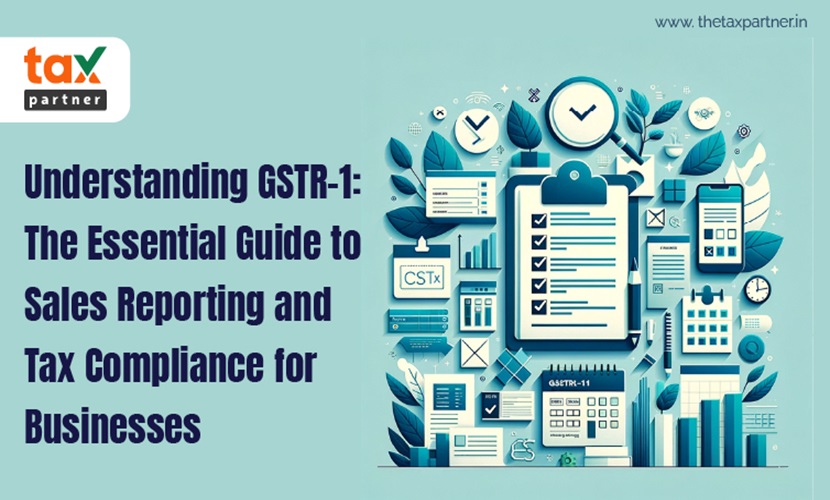Connect with us for all your queries



In essence, all individuals selling goods are required to document information regarding their sales and purchases. GSTR-1 is a crucial form that registered taxpayers must fill on a regular basis, either monthly or quarterly, based on the taxpayer's classification. This form serves as a comprehensive record of all the sales and outward supplies made by a taxpayer. Accurate completion of the GSTR-1 form is essential, as it must encompass all sales and supplies transactions conducted by the taxpayer in the relevant tax period.
"Outward Supply" refers to the act of selling or providing goods or services, or both. This can include transactions through sale, transfer, exchange, licensing, renting out, disposal, or any other agreed method conducted by a person as part of their business activities.
Every registered taxpayer must file GST returns, including GSTR-1, which documents the outward supplies for the tax period.
However, some entities are exempt from this requirement:
Taxpayers have the flexibility to choose between a monthly or quarterly filing frequency.
For example -
It is to be noted that these penalties are subject to the taxpayers annual turnover in the previous financial year.
|
s.no. |
Category of taxpayer |
CGST Late fee/day |
SGST Late fee/day |
Total late fee/day |
|
|
Annual turnover up to Rs.1.5 crore |
Rs.25 |
Rs.25 |
Rs.50 |
|
2.
|
Maximum Late Fee (up to Rs.1.5 crore turnover) |
Rs.1,000 |
Rs.1,000 |
Rs.2,000 |
|
3.
|
Annual turnover between Rs.1.5 crore - Rs.5 crore |
Rs.2,500 |
Rs.2,500 |
Rs.5,000 |
|
4.
|
Annual turnover over Rs.5 crore |
Rs.5,000 |
Rs.5,000 |
Rs.10,000 |
When a registered taxpayer has no outward supplies or sales to report for a specific tax period, it is known as NIL GSTR-1. Put simply, it indicates that there are no transactions to report in the GSTR-1 form during that particular period. It might happen if the taxpayer didn't make any sales or provide any goods or services in the reporting period, or if all transactions were exempt from GST. When this happens, the taxpayer must still submit a GSTR-1 form stating that no outward supplies were made, often known as a NIL return.
|
s.no. |
Time Period Of Delay |
CGST Late fee/day |
SGST Late fee/day |
Total late fee/day |
|
1. |
Late Fees for per-day delay |
Rs.10 |
Rs.10 |
Rs.20 |
|
2. |
Maximum Late Fee |
Rs.250 |
Rs.250 |
Rs.500 |
Initially the CGST Act was very strict towards imposing the penalties in scenario of delay in filing of GSTR-1 but side notification dated 20/2021 by CBIC reduced rates making Rs. 50 to be minimum threshold of total penalty which earlier was Rs.100 and for NIL GSTR-1 Rs. 20 as total which previously was Rs.25.
Once submitted, GSTR-1 cannot be altered or amended under the GST regime. However, any errors or mistakes can be corrected in the subsequent GSTR-1 filing for the following tax period, whether it's monthly or quarterly. This underscores the importance of careful and meticulous filing of the GSTR-1 form by the taxpayer. Failure to do so means rectification can only occur in the next return filing opportunity.
For Example
Firm named ABC opts to file the GSTR-1 monthly. For the month of january they would need to file their GSTR-1 by february 11th but upon filing of the GSTR-1 they made certain mistakes now the originally submitted form won’t open, the taxpayer will now wait till 11th march where at the time of filing the GSTR-1 they can correct the mistakes of the previous one. Same applies to the correction to be done in the quarterly submission of GSTR-1.
One of the prior objectives behind the initiation of GST regime was to digitalise indirect taxation in india, therefore now there are two ways to file GSTR-1
To successfully file GSTR-1, you need access to the following essential documents and information:
Additionally, other documents that you must have access to while filing the GSTR-1 form include:
To file GSTR-1, adhere to the following steps:
Note-
Table 14 & 15 in the GSTR-1 were introduced through notification dated 10-01-24 Advisory on GSTR-1/IFF: Introduction of New 14 and 15 tables vide Notification No.: 26/2022- Central Tax dated December 26, 2022 https://tutorial.gst.gov.in/downloads/news/updated_advisory_new_table1415_cr23892_sj_10.01.2024.pdf
After you submit the GSTR-1 Form, the recipient mentioned in the invoice will automatically receive the details of the outward supplies from the supplier. This helps maintain consistent records across different forms like GSTR-2A, GSTR-4A, and GSTR-6A.
Since the introduction of GST, our tax system has become simpler and more unified. Regular return filing helps both the government and taxpayers by reducing errors. GSTR-1 is a vital form that needs to be filed monthly or quarterly, depending on the taxpayer's category. It records all sales and outward supplies accurately. The government has made the process easier with auto-populated data and simplified forms.
If you find tax filing complicated, consider seeking expert advice from our professionals who can be your tax partners and will simplify this stringent looking procedure for you.
1. What is GSTR-1?
GSTR-1 is a return form under the Goods and Services Tax (GST) system in India. It is used by registered taxpayers to furnish details of outward supplies of goods or services or both made during a specific period.
2. What is the purpose of filing GSTR-1?
The primary purpose of filing GSTR-1 is to provide details of all sales and outward supplies made by the taxpayer. It helps in the reconciliation of data between the supplier and recipient, ensures compliance with tax regulations, and facilitates input tax credit for recipients.
3. Who needs to file GSTR-1?
All registered taxpayers who are involved in the supply of goods or services or both are required to file GSTR-1. This includes regular taxpayers, composition scheme dealers, and Input Service Distributors (ISD), among others.
4. What is the filing frequency for GSTR-1?
GSTR-1 can be filed either monthly or quarterly, depending on the taxpayer's turnover and other criteria. Monthly filing is required for taxpayers with an aggregate turnover exceeding Rs. 1.5 crores in the preceding financial year, while others have the option to file quarterly.
5. What is the format of GSTR-1?
GSTR-1 follows a structured format consisting of various sections and tables where taxpayers need to furnish specific details such as GSTIN, name of the taxpayer, turnover, details of outward supplies to registered/unregistered persons, amendments, and HSN-wise summary, among others.
6. What are the key components of GSTR-1?
The key components of GSTR-1 include details of outward supplies made to registered persons, unregistered persons, interstate supplies, exports, amendments to previous returns, and consolidated statements of advances received, among others.
7. How can I file GSTR-1?
GSTR-1 can be filed online through the GST portal using your login credentials. Taxpayers need to fill in the required details in the prescribed format, validate the data, and submit the return electronically.
8. What are the consequences of not filing GSTR-1?
Failure to file GSTR-1 within the due date may attract penalties and late fees as per GST regulations. Additionally, non-filing or late filing of GSTR-1 may impact the recipient's ability to claim input tax credit.
9. Can I revise GSTR-1 after filing?
No, GSTR-1 cannot be revised after filing. However, any errors or omissions can be rectified in the subsequent filing period.
10. Where can I get help or support for filing GSTR-1?
Taxpayers can refer to the official GST portal for user guides, FAQs, and other resources related to GSTR-1 filing. Additionally, consulting with tax professionals or seeking assistance from GST helpdesks can also be beneficial.
Tax Partner is India’s most reliable online business service platform, dedicated to helping you in starting, growing, & flourishing your business with our wide array of expert services at a very affordable cost.